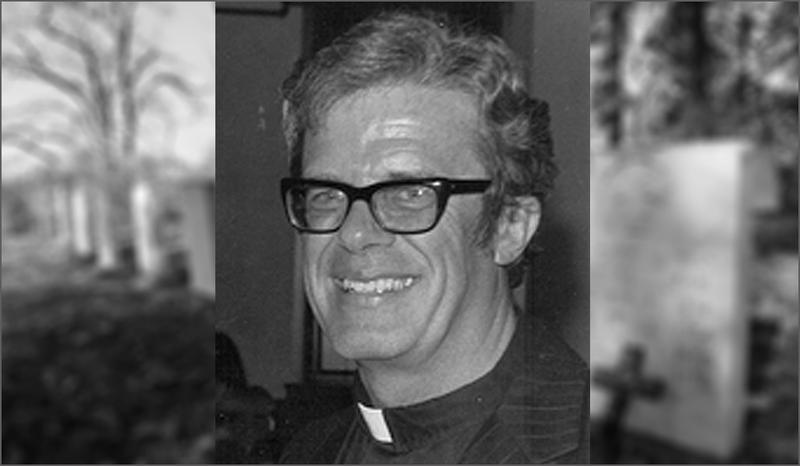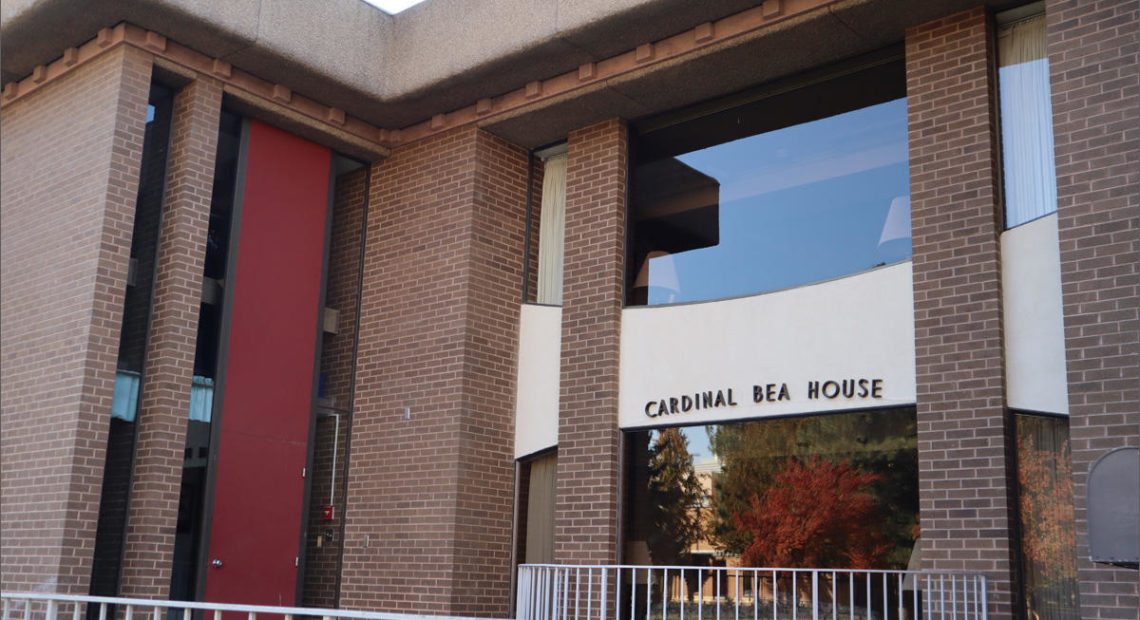
After Years Of Sexual Abuse In Native Communities, Jesuits Sent Many To Retire On Gonzaga’s Campus
Listen
BY EMILY SCHWING, AARON SANKIN & MICHAEL COREY
On the surface, Father James Poole seemed like the cool priest in Nome, Alaska. He founded a Catholic mission radio station that broadcast his Jesuit sermons alongside contemporary pop hits. A 1978 story in People magazine called Poole “Western Alaska’s Hippest DJ … Comin’ at Ya with Rock’n’Roll ’n’ Religion.”
Behind the radio station’s closed doors, Poole was a serial sexual predator. He abused at least 20 women and girls, according to court documents. At least one was 6 years old. One Alaska Native woman says he impregnated her when she was 16, then forced her to get an abortion and blame her father for raping her. Her father went to prison.
Like so many other Catholic priests around the country, Poole’s inappropriate conduct with young girls was well-known to his superiors. A Jesuit supervisor once warned a church official that Poole “has a fixation on sex; an obsession; some sort of mental aberration that makes him see sex everywhere.”
But the last chapter in his story reveals a new twist in the Catholic abuse scandal: Poole was sent to live out his retirement years on Gonzaga University’s campus in Spokane.
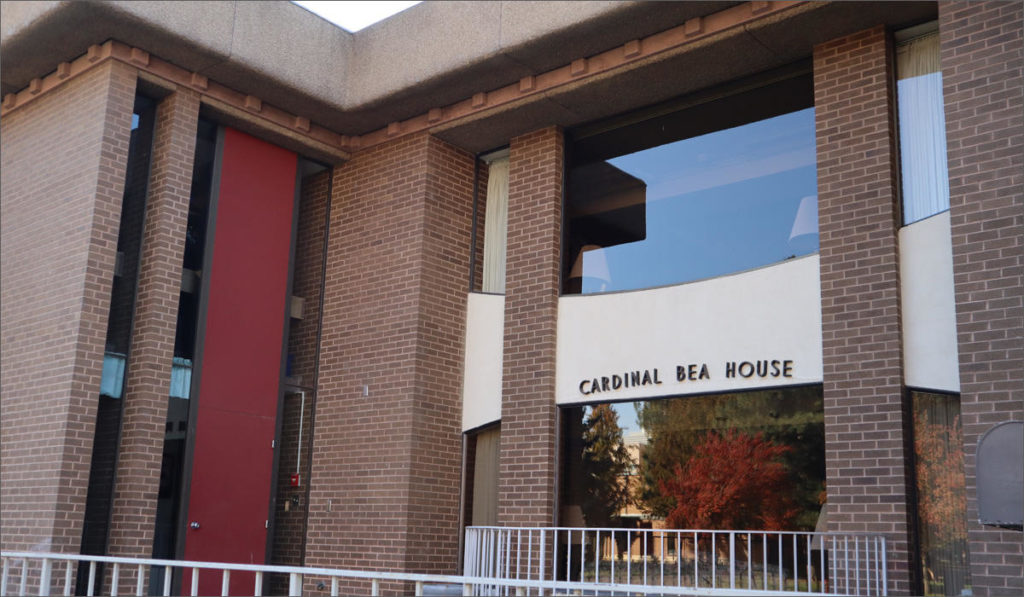
The Cardinal Bea House sits on the campus of on Gonzaga University. It played host to at least 20 Jesuit priests accused of sexual abuse. CREDIT: EMILY SCHWING/N3
For more than three decades, Cardinal Bea House on Gonzaga’s campus served as a retirement repository for at least 20 Jesuit priests accused of sexual misconduct that predominantly took place in small, isolated Alaska Native villages and on Indian reservations across the Northwest, an investigation by the Northwest News Network and Reveal from The Center for Investigative Reporting has found.
A trove of internal Jesuit correspondence shows a longstanding pattern of Jesuit officials in the Oregon Province—an administrative area that included Washington, Oregon, Montana, Idaho and Alaska—privately acknowledging issues of inappropriate sexual behavior, but not releasing that information to the public, which avoided scandal and protected the perpetrators from prosecution.
This story was produced in partnership with Reveal from The Center for Investigative Reporting, a nonprofit news organization. Get their investigations emailed to you directly by signing up at revealnews.org/newsletter.
When abuse was discovered, the priests would be reassigned, sometimes to another Native community.
Once the abusive priests reached retirement age, the Jesuits moved them to Cardinal Bea House on Gonzaga’s campus or another Jesuit residence, to comfortably spend the rest of their lives in relative peace and safety. The university administration did not respond to requests for an interview to answer whether the administration or student body were aware of the presence of known sexual offenders on campus.
The last known abusive priest was moved out of Cardinal Bea House in 2016, Jesuit records show.
Father John Whitney, the former leader of the Oregon Province who ordered Poole to move into Cardinal Bea House, said the Jesuit order is obligated to provide for priests in retirement. He said it was the only facility in the province where past offenders like Poole, then in his 80s, could be contained effectively while also receiving necessary medical care.
Poole resided at Cardinal Bea House from 2003 to 2015. If he had been allowed to live independently, without church oversight, he surely would have abused more people, even at his advanced age, Whitney said in an interview.
The house, Whitney said, was “a retirement community where he could be monitored.”
In a pair of depositions in 2005, Whitney said he did not inform Gonzaga administrators or police in Spokane about Poole’s history after moving him into Cardinal Bea House. A Spokane Police Department spokesperson said they had not received any reports, either from Gonzaga or the Jesuit order, about allegations against any residents of Cardinal Bea House.
Non-abusing Jesuits also lived at Cardinal Bea House, but there were specific “safety plans” for abusers that banned sexually abusive priests from commingling with students. The Oregon Province would not release copies of the plans. While we learned of no reports of residents abusing Gonzaga students, the restrictions were not rigorously enforced.
In a deposition in one of the several lawsuits filed against him, Poole said he regularly went to the school library and basketball games. Poole said he met with a female student alone in the living room of Cardinal Bea House when she came to interview him for a report on Alaska. Student journalists and filmmakers in 2010 and 2011 were also permitted to interview residents, including Joseph Obersinner, who worked in Native communities in Montana, Washington and Idaho. He was accused of sexual misconduct against a minor.
“We love being right in the middle of campus,” Obersinner told the school’s student newspaper. “It’s a blessing to see the active energy and happiness of youth every day.”
The House On Campus
Cardinal Bea House is a modest low-rise brick building, with large windows in front and a small carport behind. It resembles an unremarkable office building, save for the white statue of an angel-winged saint standing guard over the front entrance. On a recent crisp autumn day, a prankster had slipped a hand-rolled cigarette between the statue’s fingers.
While the building appears on campus maps and is listed in the campus directory, it’s not officially part of the private Jesuit university. Cardinal Bea House is owned by the Jesuit order of the Catholic Church.
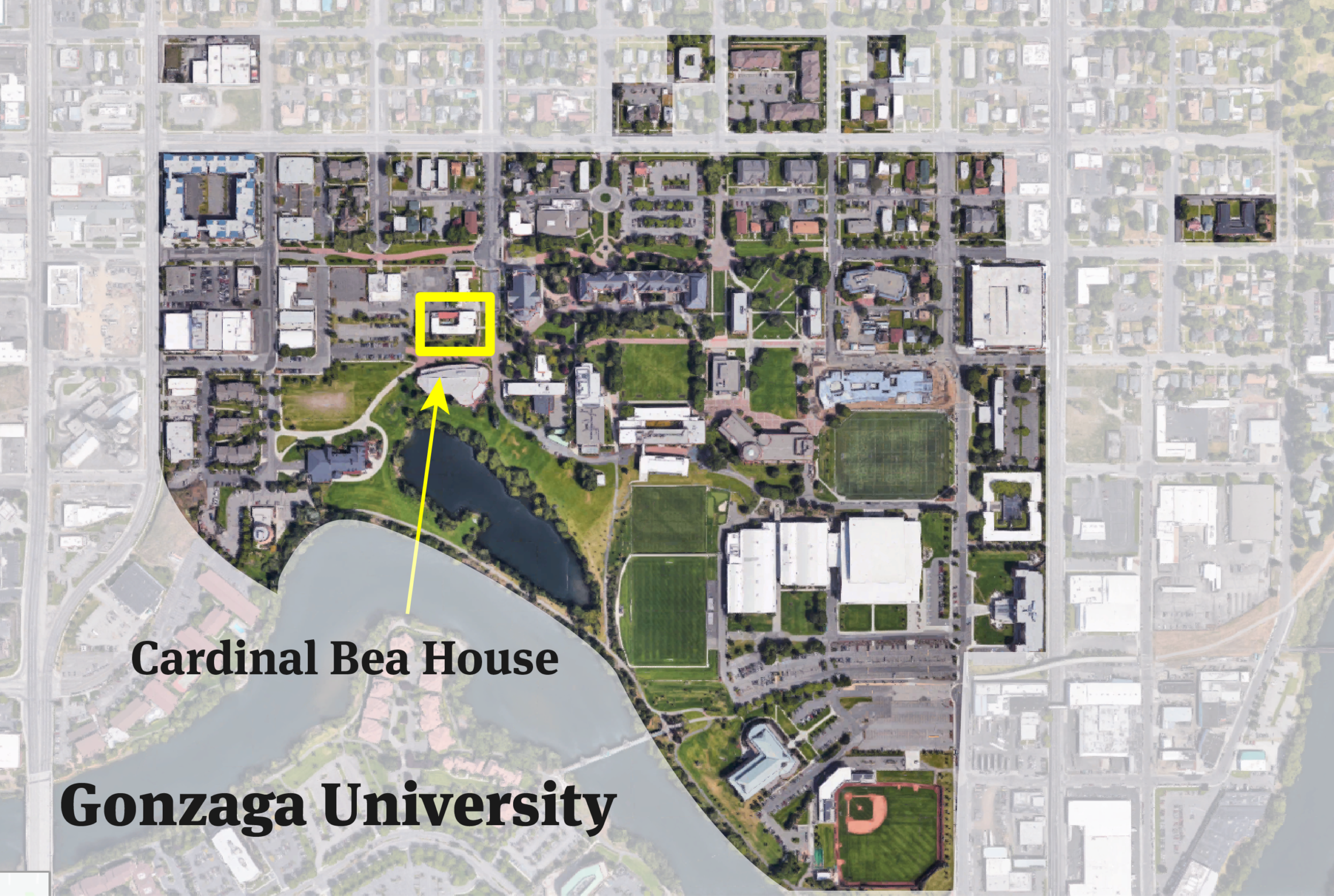
While Cardinal Bea House appears on Gonzaga campus maps and is listed in the campus directory, it’s not officially part of the private Jesuit university. CREDIT: GABRIEL HONGSDUSIT / REVEAL
Poole was joined at Cardinal Bea House by other priests whose abuse was known, often for years, by the Jesuit order.
Father James Jacobson, sent there in the mid-2000s, was accused of sexual abuse by members of the Alaska Native community of Nelson Island. He claimed he never forced anyone to have sex, saying in a deposition that he had consensual sex with seven Native women. He admitted to fathering four children and using church funds to hire prostitutes in Anchorage and Fairbanks when he was principal of a Jesuit boarding school in Glennallen.
Another priest, Henry Hargreaves, accused of sexually assaulting young boys, was sent to Cardinal Bea House by 2003, and subsequently allowed to lead prayer services in at least four Native American communities on two reservations in Washington state.
The abusive Jesuits at Cardinal Bea House were part of the Oregon Province’s outsized problem with sexual misconduct. The province had 92 Jesuits accused of sexual abuse, by far the most of any province in the country, according to data we compiled from church records, a database maintained by advocates for sex abuse victims, and information released earlier this month by the Jesuits. In addition, about 80 percent of accused abusers worked in Native communities in the Oregon Province.
Poole has been described as charismatic, outgoing and narcissistic, so he was perfectly suited for his role as the voice of KNOM, the radio station he founded in 1971. Elsie Boudreau, an Alaska Native, was a station volunteer and one of Poole’s victims. From the time she was 10 until she was 16, she volunteered at KNOM.
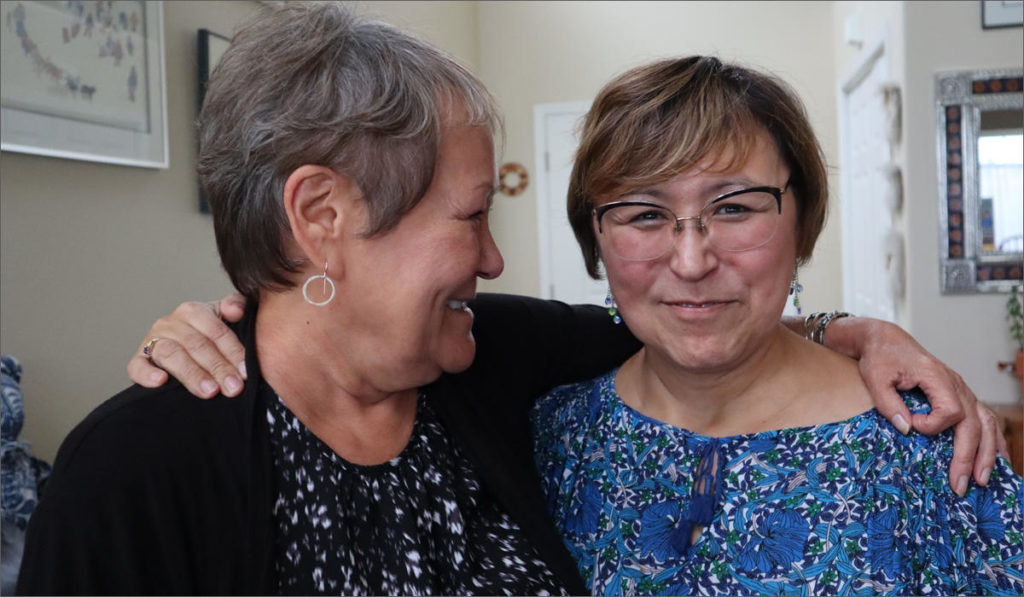
Sisters Elsie Boudreau, right, and Florence Busch grew up in St. Mary’s, a tiny Alaska Native village in Western Alaska. Both of them worked at KNOM, a Catholic mission radio station in Nome, Alaska. Elsie filed a lawsuit against the Jesuit priest who founded the station in 2003. CREDIT: EMILY SCHWING/N3
Boudreau said in an interview that when she was 11 or 12, during a Saturday music request show in which they were alone in the studio, Poole would kiss her on the lips and fondle her, something she didn’t realize was wrong until she was much older. He also made her sit on his lap and lie on top of his body.
For Boudreau, it was slap in the face that Poole lived out his retirement comfortably until he died early this year. “To me, what that says is they are taken care of,” Boudreau said. “They are protected by the Catholic Church, when the victims were never protected.”
The Jesuits’ Deep Roots In Native Communities
The Catholic Church was deeply embedded in the Native communities of Alaska and Indian reservations in the Northwest. In the early 1900s, the Jesuits had established a school and an orphanage in Elsie Boudreau’s hometown, the predominantly Alaska Native community of St. Mary’s in the Yukon-Kuskokwim Delta.
Jesuits, officially called the Society of Jesus, are a Catholic religious order founded in the 1500s. While Jesuits can work in various roles from parish priests to teachers, the order is known for its academic and socially conscious bent. There are more than 100 Jesuit high schools, colleges and universities in North America.
Jesuit priests were formidable figures in small Native villages, presiding over daily life from Mass to marriages, baptisms to burials; even teaching catechism lessons, where some of the abuse of the youngest victims took place. Boudreau said she viewed her Catholicism as more central to her identity than being Yup’ik. That religious identity was shattered by her abuse.
“The whole premise behind the Catholic Church and their mission with the Native people, with indigenous people, was to strip them of their identity,” Boudreau said. “And so sexual abuse was one way. I think it’s intentional when you have an institution that is aware of problem priests, perpetrator priests, and moves them to places where they believe that people are ‘less than,’ where they believed the people there would not speak out.”
In 2002, two other abuse victims in Boudreau’s community filed a lawsuit against the church. Learning of the suit from a news story, Boudreau, then in her early 30s, had a shock of recognition. She, too, had suffered abuse, and no longer wanted to remain silent.
Boudreau reported her abuse and was deeply unsatisfied with the response. The region’s presiding bishop eventually invited her to a meeting, but Boudreau said he didn’t seem to understand how the abuse had affected her life.
“It was very clear he didn’t care about what happened to me,” Boudreau said. “He didn’t acknowledge that little girl who was hurt and say, ‘I’m sorry this happened to you, what can I do?’ Instead, I became a liability.”
Yet, Jesuit leadership had known about James Poole’s behavior for longer than Boudreau had been alive. In a 1960 letter to a Jesuit official, local Jesuit leader Segundo Llorente fretted over Poole’s conduct. Poole regularly had long, one-on-one conversations with young girls about sex, Llorente wrote. Llorente’s letter speculated that Poole, “has a fixation on sex; an obsession; some sort of mental aberration that makes him see sex everywhere. Some think that may be (sic) he is projecting outwardly what is eating him inwardly … he is deliberately placing himself at all times in dangerous situations.”
There might have been some personal insight in those words. The names of both Llorente and the Alaska church official with whom he was corresponding, Father Paul O’Connor, appeared on a list released by the Fairbanks Diocese in 2009 of priests accused of sexual misconduct.
Despite Llorente’s warning, Poole’s abuse of minors and young women in Alaska went on for decades, according to attorneys who represented clients, as well as letters from church officials and other court documents. At least one victim accused him of rape.
In another letter from 1986, which has not previously been made public, Bishop Michael Kaniecki of Fairbanks wrote to Archbishop Francis Thomas Hurley of Anchorage: “Hopefully, my letter will nip this mess in the bud. Tried to cover all bases, and yet not admit anything.”
In 1988, Poole was removed from his position at KNOM after young women who had volunteered at the station wrote letters to the bishop in which they accused Poole of sexual misconduct.
The following year, Father Frank Case, the head of the Oregon Province, endorsed Poole for a new position. Case is currently vice president at Gonzaga, an adviser to the school’s president, and chaplain for the school’s nationally ranked men’s basketball team, the Bulldogs.
He wrote a letter to the Catholic chaplains association backing Poole’s application to become a chaplain at St. Joseph Medical Center in Tacoma, Washington.
“(Poole) is a Jesuit priest in very good standing, and it is my strong expectation that he will serve in such a ministry in a manner that is both generous and effective,” Case wrote. Poole got the job, working at the hospital until 2003.
In a 2008 deposition, Case said he did not review Poole’s personnel file before writing the letter because he had no indication of misconduct. In a statement through Gonzaga University’s public relations office, Case said he did not have access to Poole’s personnel file.

These Catholic directories, from the Gonzaga University library, list the locations of Catholic priests over time, showing how Jesuits were shuffled around following abuse accusations. CREDIT: EMILY SCHWING/N3
It wasn’t until 1997, 37 years after Llorente’s letter of caution, that church officials finally came to see their Poole problem as critical. That December, the bishop of Fairbanks sent a letter to the head of the Oregon Province, at least the third provincial to deal with Poole’s sexual misconduct.
“Unfortunately, more skeletons keep falling out of the closet … if we do not make a clean cut with Poole, it could jump up and bite us,” he wrote, noting a potential whistleblower was threatening to publicly expose the extent of Poole’s wrongdoings.
The following year, the bishop sent another letter to the province head urging Poole’s old sermons and ministerial messages be removed from the KNOM’s airwaves entirely. “(We could) end up with a public scandal and a possible law suit (sic),” the letter reads. “It is my fear … that if the wrong person hears Jim’s voice anywhere, it might just be the straw that breaks the camel’s back.”
Those fears were prescient. In 2003, the same year Poole was forced to retire to Cardinal Bea House, Boudreau became the first person to sue Poole and the church and not withhold her name from the public.
It was Boudreau’s only avenue of redress since the statute of limitations had run out on prosecuting her claim in criminal court. At the time, Alaska had a five-year time frame for prosecuting sexual abuse of minors. She’s one of over 300 Alaska Native victims of child sex abuse by clergy.
In a deposition for the lawsuit, Poole admitted abusing Boudreau. He denied ever raping anyone. He justified his actions with Boudreau and other victims because they fell short of sexual intercourse. “I thought I was bringing love into the life of other persons,” he said.
Boudreau’s suit was settled in 2005 for $1 million. It was followed by at least five other lawsuits, including cases filed in Portland, Nome, Alaska, and Yakima, Washington, specifically naming Poole and accusing him of widespread abuse.
Hundreds of other suits followed, naming dozens of other sexually abusive priests active in the Oregon Province. The Jesuits settled all of this litigation for a reported $166 million, the costs of which forced the province to declare bankruptcy in 2009. It was the third-largest settlement in Catholic Church history.
Stories like Poole’s echo across Alaska Native communities. St. Mary’s has just 500 residents, but at least 15 priests accused of sexual abuse were stationed there between 1927 and 1998. It was so pervasive that Boudreau says at least two of her seven siblings and two of her cousins were also sexually assaulted by Jesuit clergy.
The names of religious and lay people accused of abuse who lived in Alaska at some point in their tenure with the church must be listed and published every year by the Fairbanks Diocese as part of the 2010 bankruptcy settlement. As of late October, the diocese listed 46 people.
One man on the list is the aforementioned Father James Jacobson, accused of abuse in 1967 by members of the Alaska Native community of Nelson Island. In a letter at the time, the Jesuit superior in Alaska, Jules Convert, said he wasn’t sure of the veracity of the allegations against Jacobson because the people of Nelson Island “are not yet advanced enough to give impartial and true testimony.”
Jacobson was sent into retirement at Cardinal Bea House by 2005. Convert was also accused of sexually abusing over a dozen young boys in Alaska.
“I Have To Take Responsibility For This”
In 2002, John Whitney was installed as the leader of the Oregon Province. He had to deal with a flood of accusations against priests in the province, starting days after taking the position. It was a situation, he said, for which his prior training had not adequately prepared him.
A year later, Elsie Boudreau filed her lawsuit, and Whitney took action against James Poole. He immediately ordered Poole to stop celebrating Mass and sent him directly to Cardinal Bea House. “You are not to have any unsupervised contact with any minors nor are you to meet alone with any women,” Whitney wrote.
Whitney said Cardinal Bea House was the only place where Poole could be monitored, but Poole moved freely throughout campus and, at least on one occasion, met alone with a female student.
Whitney told us in a recent interview that the order didn’t contact the local police department because Poole, and other priests with accusations against them, had not been criminally charged.
Gonzaga University wouldn’t answer questions about whether top officials knew about abusive priests at Cardinal Bea House. University officials declined multiple requests for interviews over a six-week period. Several top university officials, however, held leadership roles in the Jesuits’ Oregon Province as the sex abuse scandal unfolded.
Now a self-described “simple parish priest” in Seattle, Whitney is still processing his role in the crisis.
“I think some of the people deserved to be in jail,” Whitney said. “We knew we couldn’t put them in jail. I felt we had a responsibility to watch over them and that’s what we tried to do. Now, were sometimes the jailers overly beneficent, overly kind? Maybe. I don’t know. It’s hard to be a jailer.”
Whitney was candid about what he owed to survivors and their families. “I have to take responsibility for this, personally. It can’t be something that is delegated to someone else,” he said. “They deserved to confront me.”
Asked if he thinks Poole is in hell, Whitney said he believes Poole is in a sort of purgatory. “What I believe purgatory to be is that we all have to be purged of the things we hold onto,” Whitney said. “In being purged of those things, we have to experience what we put others through.”
Whitney said the church needs to come to a public reckoning, an opening up of the archives to show it is serious about stamping out abuse. The recent grand jury report out of Pennsylvania, which showed decades of abuse kept hidden from public view by the church, is work that should have been done by the church itself, he said.
Earlier this month, Jesuits West, the new province created with the 2017 merger of the Oregon and California provinces, voluntarily released the names of priests accused of sexual misconduct with minors or “vulnerable adults.” But the new list omits at least 13 priests previously accused publicly in lawsuits and bankruptcy documents.
Tracey Primrose, a spokeswoman for Jesuits West, said more names could be added in the future after an external review due to be completed by spring, but did not explain the omissions.
The Jesuits Have A New Place To Send Abusers
There are no longer any known abusive priests at Cardinal Bea House. In the past couple of years, they have been relocated south to the Sacred Heart Jesuit Center in Los Gatos, California.
Sacred Heart is a former training school, where some of the abusive priests began their preparation for Jesuit life decades ago. The facility is hidden behind a hilltop winery, which also used to be owned by the Jesuits and was used to produce Communion wine. The order stopped its wine production in 1986 and the winery is now operated by a secular company.
The goal of the reshuffling, John Whitney said, was to place the priests in a more secure and isolated location. Since many of the offending Jesuits are older and declining in health, Sacred Heart was also a place where they could receive better medical care.
But Sacred Heart has problems of its own. By moving admitted sexual offenders into a facility that also services vulnerable people, it created an environment where predators had space to commit abuse.
In 2002, two mentally disabled men working as dishwashers at the facility received a combined $7.5 million settlement from the order for decades of sexual abuse by Jesuit priest Edward Thomas Burke and Brother Charles Leonard Connor. After a friend of one of the victims went to police, both men were convicted and required to register as sex offenders.
The Jesuits also settled a separate lawsuit for $1.6 million after an abused priest, James Chevedden, killed himself.
He, too, was sexually abused by Connor when he was sent to Sacred Heart after suffering a mental breakdown. When Chevedden learned Connor was returning to Sacred Heart, and that other abusive clergy were going to be sent there, he asked to be moved. When his request was denied, he killed himself, according to the lawsuit filed by Chevedden’s father.
California’s database of sex offenders only lists one person residing at Sacred Heart, Gary Uhlenkott, a Jesuit priest and former Gonzaga University music professor who was sentenced to six months in jail in May after pleading guilty to possessing child pornography. However, the list released earlier this month of priests accused of sexually abusing minors shows at least seven currently living at Sacred Heart.
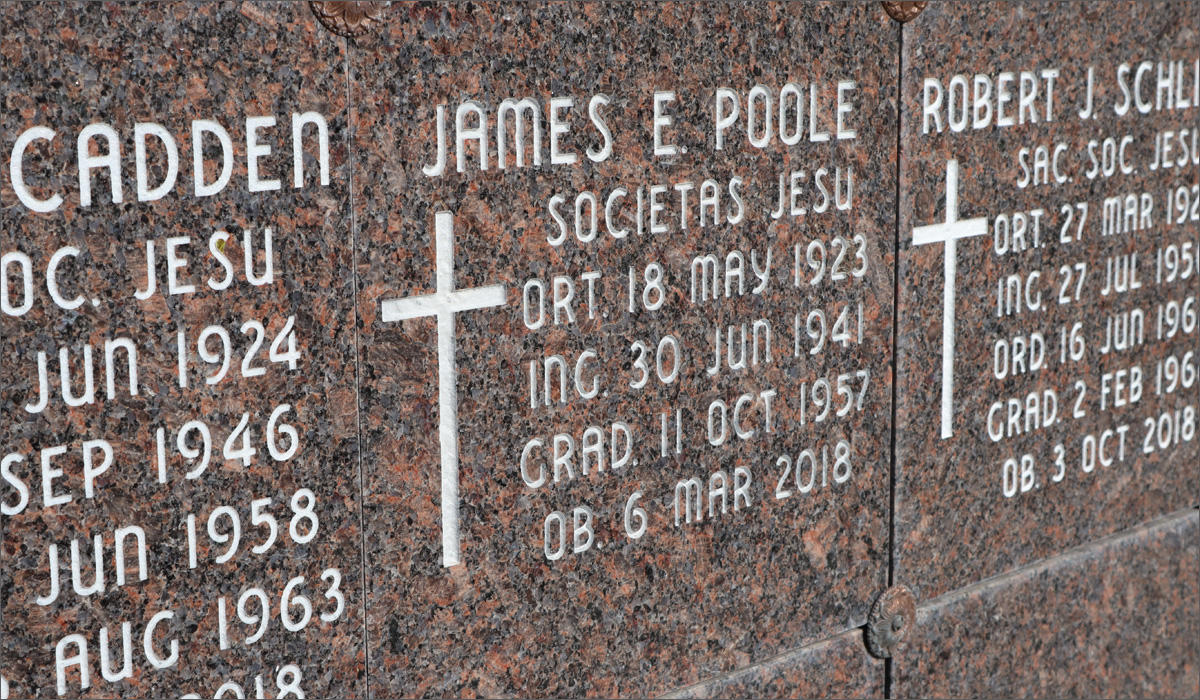
James Poole’s remains are interred at Mount St. Michael in Spokane. Over the course of his life, Poole was accused of sexually abusing at least 20 women. CREDIT: EMILY SCHWING/N3
James Poole died in March at Sacred Heart. His remains were sent back to Spokane, where they were inurned at the Jesuits’ grassy cemetery on the outskirts of town.
While he was stationed at Cardinal Bea House, Poole’s sole responsibility was to maintain the cemetery grounds.
There, Poole’s remains rest amid 54 other Jesuits who were also accused of sexual abuse. They’re outside the gate of a K-12 school.
The carefree voices of children the same age as Elsie Boudreau when she was abused float over the grounds during recess.
This article was provided to The Associated Press by the nonprofit news outlet Reveal from The Center for Investigative Reporting. Subscribe to its newsletter: revealnews.org/newsletter.
Emily Schwing is the Inland Northwest correspondent for the public radio Northwest News Network and Northwest Public Broadcasting. This story was edited by Andrew Donohue and Narda Zacchino and copy edited by Stephanie Rice.
Emily Schwing can be reached at emily@nwnewsnetwork.org, Aaron Sankin can be reached at asankin@revealnews.org and Michael Corey can be reached at mcorey@revealnews.org. On Twitter: @EmilySchwing, @asankin and @mikejcorey.
Related Stories:
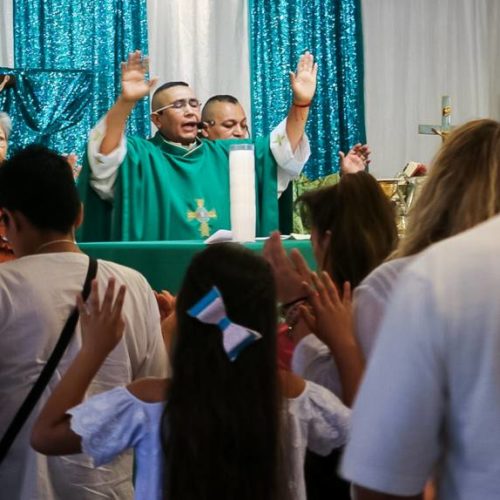
‘He Played With People’s Minds’: Former Yakima Priest Moves To California, Bringing Abuse Allegations
An investigation by KQED shows that Jesús Antonio Castañeda Serna, a former Catholic priest in the Diocese of Yakima, had been accused before and has moved from the Catholic Church to the Anglican Church and then to another religious group without undergoing complete background checks — or any at all.
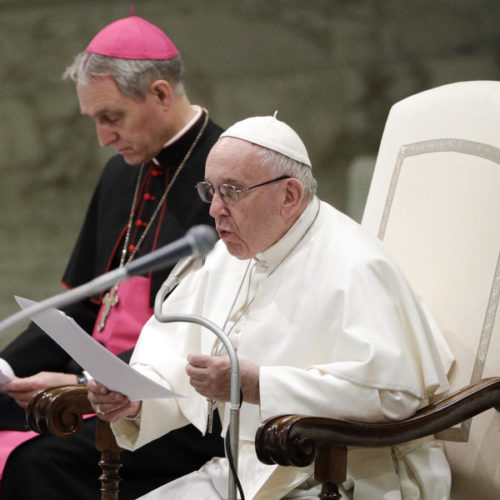
As Pope Holds Sex Abuse Summit, U.S. Catholics Not Hopeful For ‘Bold Moves’
Not surprisingly, when Pope Francis summoned more than 100 bishops to a meeting in Rome to address the “Protection of Minors in the Church,” the announcement raised expectations that it could mark a turning point in the Church’s lagging response to the ongoing clergy abuse crisis. The three-day meeting begins Thursday.
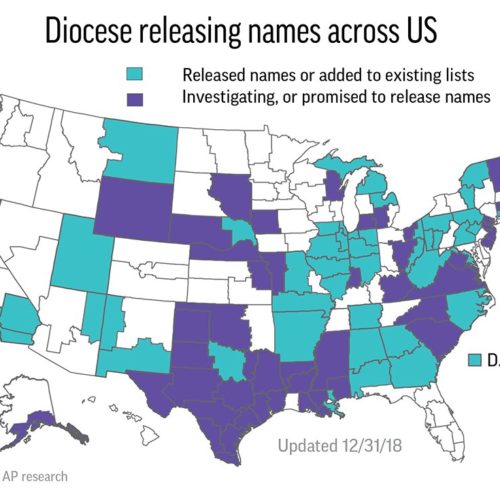
2018 Brought A Big Rise In U.S. Catholic Dioceses Naming Accused Clergy
Nearly 50 dioceses and religious orders have publicly identified child-molesting priests in the wake of the Pennsylvania report issued in mid-August, and 55 more have announced plans to do the same over the next few months, the AP found. Together they account for more than half of the nation’s 187 dioceses.

